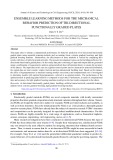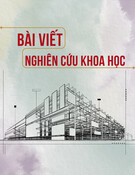
Journal of Science and Transport Technology Vol. 2 No. 4, 26-42
Journal of Science and Transport Technology
Journal homepage: https://jstt.vn/index.php/en
JSTT 2022, 2 (4), 26-42
Published online 28/12/2022
Article info
Type of article:
Original research paper
DOI:
https://doi.org/10.58845/jstt.utt.2
022.en.2.4.26-42
*Corresponding author:
E-mail address:
anhnt@utt.edu.vn
Received: 05/12/2022
Revised: 20/12/2022
Accepted: 22/12/2022
Development of effective XGB model to
predict the Axial Load Capacity of circular
CFST columns
Indra Prakash1, Raghvendra Kumar2, Thuy-Anh Nguyen3,*, Phuong-Thao Vu4
1Dy. Director General (R), Geological Survey of India, Gandhinagar 82010,
India.
2Department of Computer Science and Engineering, GIET University,
Gunupur-765022, India.
3University of Transport Technology, Hanoi 100000, Vietnam.
4University of Transport and Communications, Hanoi 100000, Vietnam.
Abstract: The Axial Load Capacity (ALC) of Concrete-Filled Steel Tubular
(CFST) structural members is regarded as one of the most crucial technical
factors for the design of these composite structures. This work proposes the
development and application of the Extreme Gradient Boosting (XGB) model
to forecast the ALC of circular CFST structural components using the affecting
input parameters, namely column diameter, steel tube thickness, column
length, steel yield strength, and concrete compressive strength. A dataset of
2073 experimental results from the literature was used for the model
development. The performance of the XGB model was evaluated using
statistical criteria such as Root Mean Square Error (RMSE), Mean Absolute
Error (MAE), Coefficient of Determination (R2), and Mean Absolute Percentage
Error (MAPE). The five-fold cross-validation technique and Monte Carlo
simulation method were used to evaluate the model's performance. The results
show good performance of the XGB model (R2 = 0.999, RMSE = 242.757 kN,
MAE = 157.045 kN, and MAPE = 0.057) in predicting the circular CFST’s ALC.
Keywords: Concrete-filled steel tube; axial load capacity; machine learning,
Extreme gradient boosting.
1. Introduction
Concrete-Filled Steel Tube (CFST) columns
are a type of composite structure made of hollow
steel tubes filled with concrete. Because of many
advantages over hollow steel columns and
reinforced concrete columns [1–4], this type of
structure is prevalent in modern construction.
These advantages include high axial bearing
capacity, good ductility and strength, large energy
absorption capacity, convenient construction,
material savings, and high fire resistance [5–7]. In
addition, because there is no need for formwork,
the construction process is quicker. It also costs
less to construct and they are more
environmentally friendly because steel tubes can
be reused along with recycled aggregates in
concrete [8–10]. According to several studies
[11,12], CFST columns exhibit excellent efficiency
under compression. As a result, the cross-section
of the chosen CFST column is frequently
symmetrical, such as a circular, square, or
rectangle. The circular CFST column is the most
often utilized due to its excellent confinement
performance, higher stiffness, and yield strength
[13–15].
Numerous investigations have been


















































